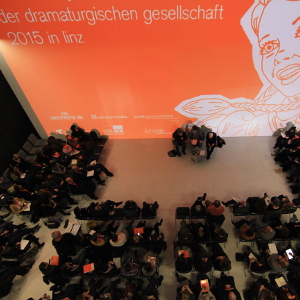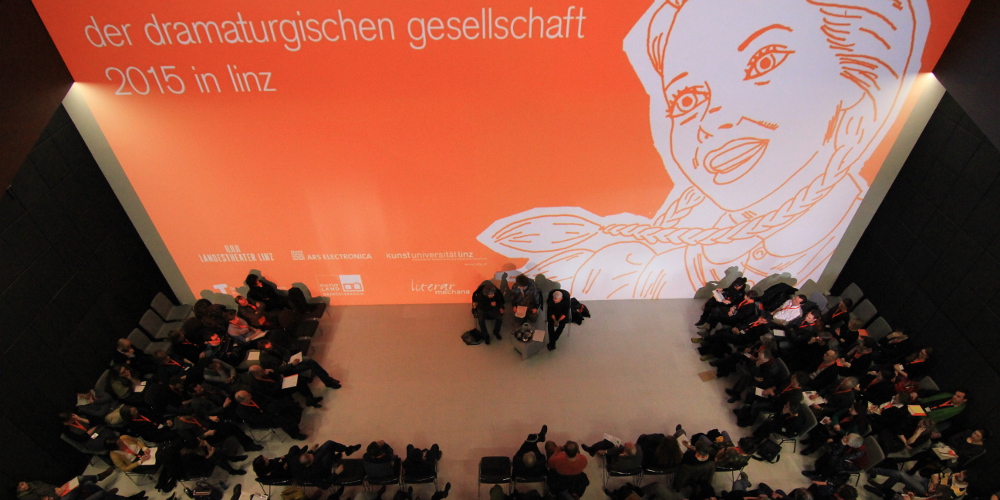 The 2015 Dramaturgische Gesellschaft (German Speaking Dramaturgs Society) conference was held in Linz. As part of a cooperation with the DG (Dramaturgische Gesellschaft) event organisers and the Landestheater Linz, the Ars Electronica provided a special program for the event. The program started with a tailored highlights tour of the Ars Electronica Center followed by 2 days of custom designed modules and events planned by the Ars Electronica Futurelab.
The 2015 Dramaturgische Gesellschaft (German Speaking Dramaturgs Society) conference was held in Linz. As part of a cooperation with the DG (Dramaturgische Gesellschaft) event organisers and the Landestheater Linz, the Ars Electronica provided a special program for the event. The program started with a tailored highlights tour of the Ars Electronica Center followed by 2 days of custom designed modules and events planned by the Ars Electronica Futurelab.
 Researcher & Producer Kristefan Minski introduces the upcoming AEC/DG program and provides an introduction to media art performance history, significant historical examples from the Ars Electronica Archive and the current performance research focus of the Ars Electroncia Futurelab.
Researcher & Producer Kristefan Minski introduces the upcoming AEC/DG program and provides an introduction to media art performance history, significant historical examples from the Ars Electronica Archive and the current performance research focus of the Ars Electroncia Futurelab.
A presentation on contemporary performance frames and the usage of media art within those frames. Comparisons will be drawn from the historical association of Ars Electronica and its role as a platform provider for new performance. A closer examination of more recent projects from the Ars Electronica Prix and Futurelab provide some sketches of where, how and what the future frames could be.
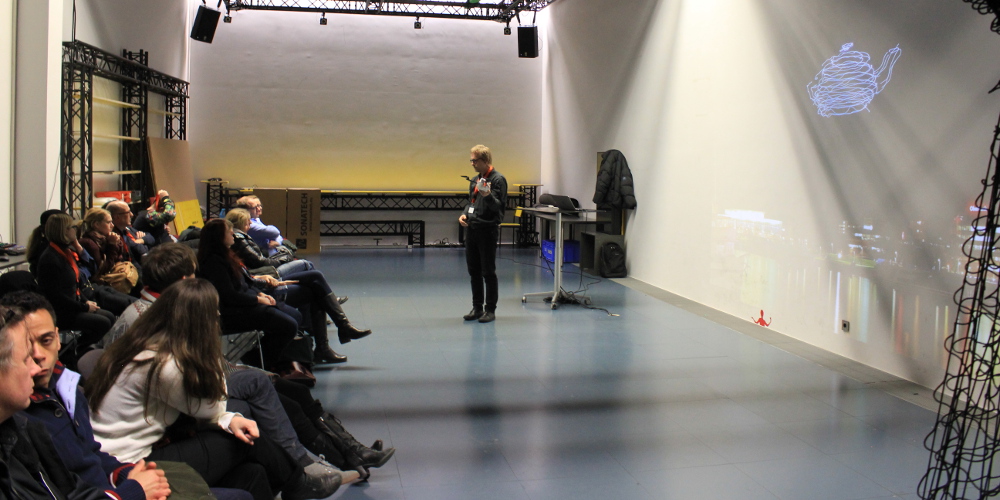 Ars Electronica Futurelab Director Horst Hörtner gives a unique behind the scenes look at the spaxels project, development and ongoing research initiative. Smart Atoms are the latest enhanced and upgraded version of the spaxels, developed by Ars Electronica Futurelab. Instead of being equipped with LEDs, the quadcopters are interlinked as flying building blocks. This makes it possible not only to form visual likenesses but also to generate objects with material-virtual characteristics.
Ars Electronica Futurelab Director Horst Hörtner gives a unique behind the scenes look at the spaxels project, development and ongoing research initiative. Smart Atoms are the latest enhanced and upgraded version of the spaxels, developed by Ars Electronica Futurelab. Instead of being equipped with LEDs, the quadcopters are interlinked as flying building blocks. This makes it possible not only to form visual likenesses but also to generate objects with material-virtual characteristics.
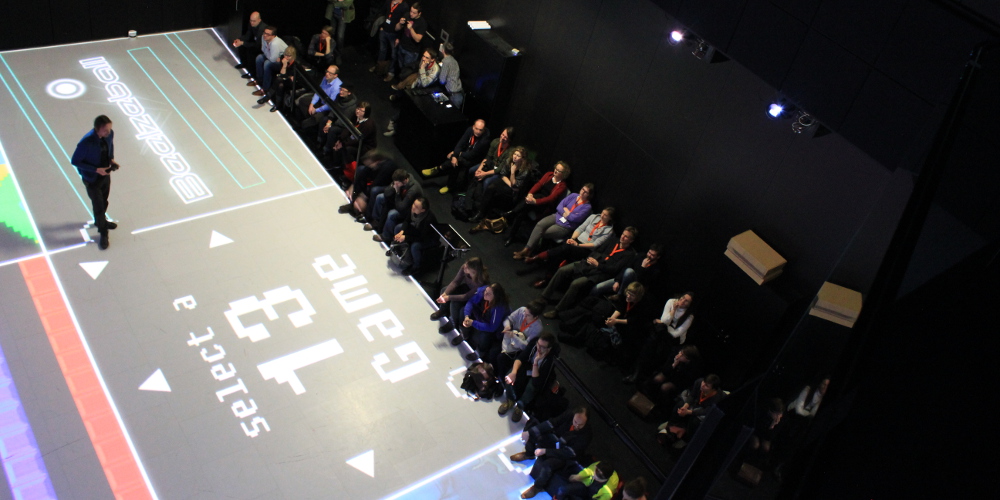 Jeremiah Diephuis from the University of Applied Sciences (Hagenberg) presents and demonstrates interactive gaming projects in Deep Space. Each time these computer games are played is like a kind of Art performance, where the players take both a performer and public role. The medium of the computer game is no longer limited to the private “stage” of a domestic living room or the dark , anonymous premises of a gambling hall . This event in Ars Electronica Deep Space shows several game prototypes for the interactive space, in which the entire audience can also help to shape the game experience.
Jeremiah Diephuis from the University of Applied Sciences (Hagenberg) presents and demonstrates interactive gaming projects in Deep Space. Each time these computer games are played is like a kind of Art performance, where the players take both a performer and public role. The medium of the computer game is no longer limited to the private “stage” of a domestic living room or the dark , anonymous premises of a gambling hall . This event in Ars Electronica Deep Space shows several game prototypes for the interactive space, in which the entire audience can also help to shape the game experience.
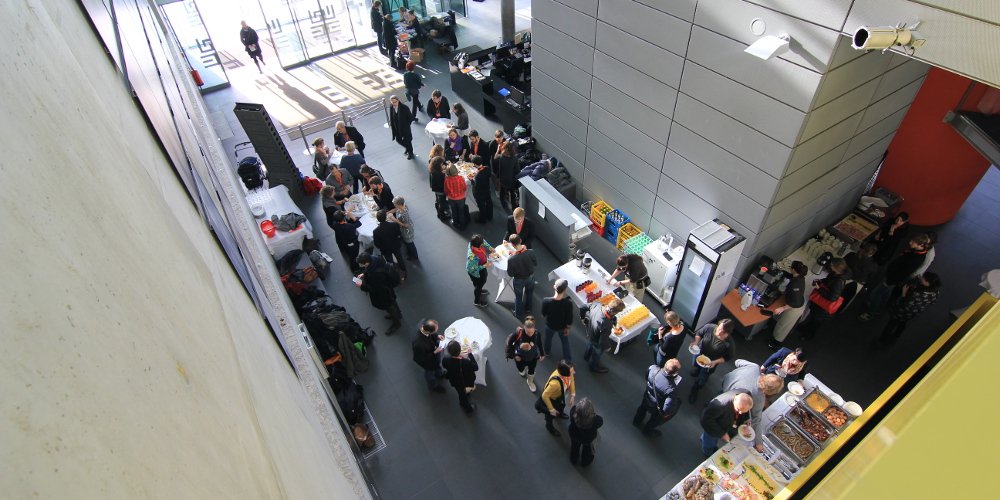 Conference delegates meet in the Ars Electronica center for breakfast and networking.
Conference delegates meet in the Ars Electronica center for breakfast and networking.
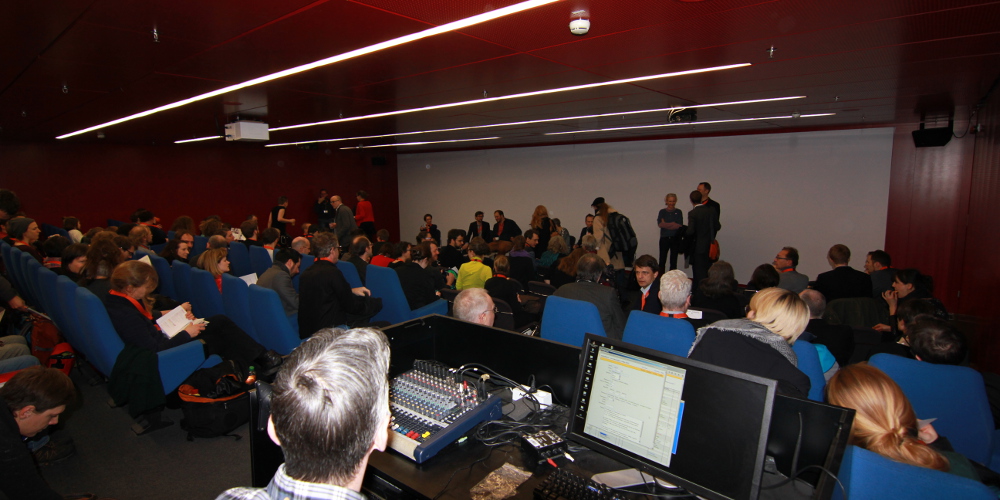 Then converge in the seminar room for the annual nomination and voting agenda for the board.
Then converge in the seminar room for the annual nomination and voting agenda for the board.
 A conference feature event: “He He Pop: Wie viel Pop vertragen unsere Spielpläne?” is staged in Deep Space.
A conference feature event: “He He Pop: Wie viel Pop vertragen unsere Spielpläne?” is staged in Deep Space.
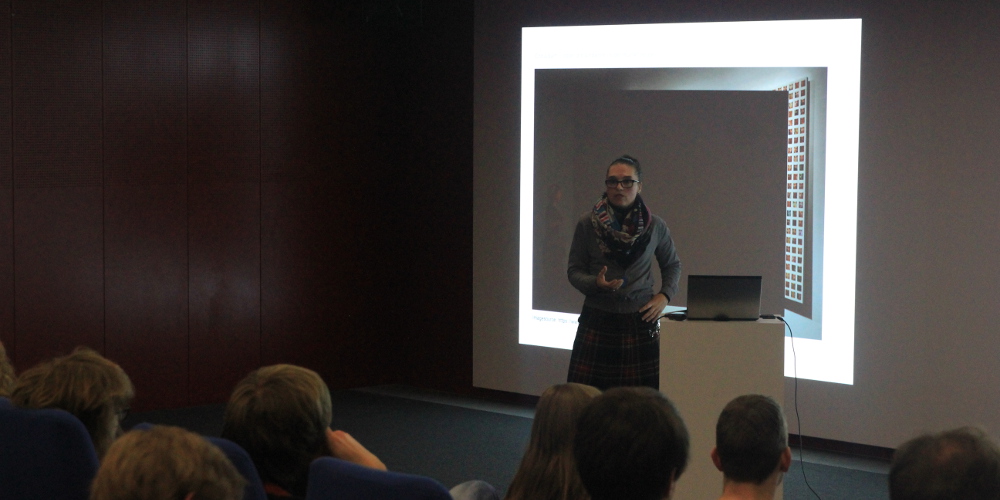
Manuela Naveau from Ars Electronica Exports discusses research topics from her recently completed thesis on the subject of Crowd and Art. An art project that builds on participation by different people is not an invention of the Internet alone but it is the Internet, and in particular the social web initiatives, that provides an unprecedented crowd for participation in artistic processes. The internet provides not only new models of participation, in reference to artistic processes, but has an impact on new ways of living together, of communicating and of exchanging that has an impact on our culture in general and when searching for new theoretical models.
 Following a presentation on Robots & Performance, Ars Electronica Futurelab key researcher Dr. Martina Mara gives a demonstration of the Telenoid robot. From the robotic caregiver to a postman drone we will increasingly see in the coming decades the inclusion of robots in our everyday lives. But even in art and performance, the range of autonomous machines are used and varied. As dramatic actors between science fiction and social factsheet they trigger the audience provocation and amazement, horror or even empathic concern. The presentation goes into the current state of robotic development and shows example projects in the artistic environment of the Ars Electronica, which raise questions about the psychology of human-robot relationships.
Following a presentation on Robots & Performance, Ars Electronica Futurelab key researcher Dr. Martina Mara gives a demonstration of the Telenoid robot. From the robotic caregiver to a postman drone we will increasingly see in the coming decades the inclusion of robots in our everyday lives. But even in art and performance, the range of autonomous machines are used and varied. As dramatic actors between science fiction and social factsheet they trigger the audience provocation and amazement, horror or even empathic concern. The presentation goes into the current state of robotic development and shows example projects in the artistic environment of the Ars Electronica, which raise questions about the psychology of human-robot relationships.
 ‘Anatta’ Media Art Dance Performance in Deep Space by Viktor Delev and Joanna Gruberska. Followed by Q & A Discussion. Do the projections programmed by Victor Delev determine the movements of dancer Joanna Gruberska in Deep Space, or does her sequence of steps choreograph the visuals? Laser tracking is the medium that interlinks dancing body and software. In their work together, Delev and Gruberska aim to further close the gap between performance and interactive art while at the same time maximizing their respective independence within the scope of this collaboration.
‘Anatta’ Media Art Dance Performance in Deep Space by Viktor Delev and Joanna Gruberska. Followed by Q & A Discussion. Do the projections programmed by Victor Delev determine the movements of dancer Joanna Gruberska in Deep Space, or does her sequence of steps choreograph the visuals? Laser tracking is the medium that interlinks dancing body and software. In their work together, Delev and Gruberska aim to further close the gap between performance and interactive art while at the same time maximizing their respective independence within the scope of this collaboration.
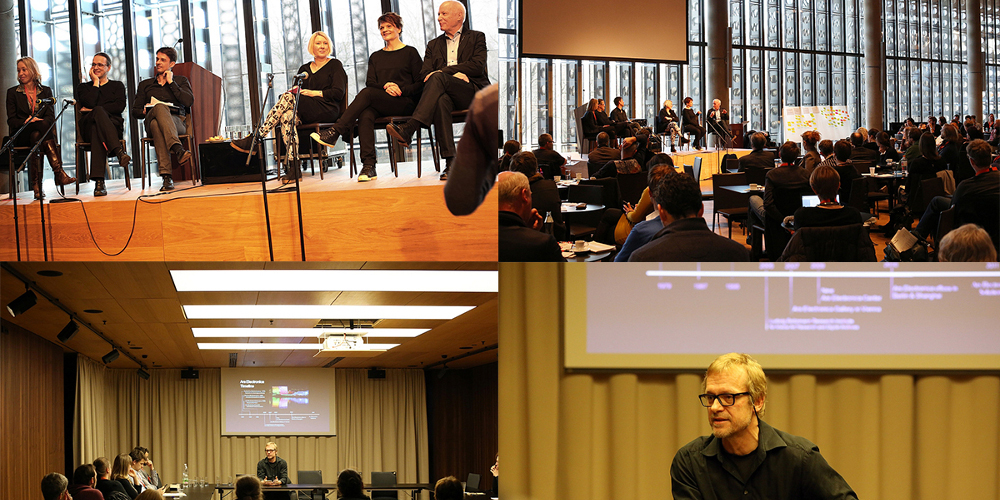 Ars Electronica Artistic Director Gerfried Stocker and Futurelab Director Horst Hörtner were also invited to participate as part of the larger DG program at the music theatre Linz.
Ars Electronica Artistic Director Gerfried Stocker and Futurelab Director Horst Hörtner were also invited to participate as part of the larger DG program at the music theatre Linz.
Credits:
Text by Kristefan Minski
Photos by Kristefan Minski<
Anatta Performance Photos by Florian Vogenedder
Musiktheater photos by Rheinhard Winkler
Ars Electronica DG Program:
Program Manager (Content and Curation): Kristefan Minski
Logistics and Support: Kathrin Obernhumer
Module Presenters:
Viktor Delev (MK/AT), Joanna Gruberska (PL): ‘Anatta’ Media Art Dance Performance
Dr. Martina Mara (AT): Robots & Performance
Manuela Naveau (AT): Crowd & Art
Jeremiah Diephuis (AT): Games, Co-located Play & Performance
Horst Hörtner (AT): Spaxels: Smart Atoms
Kristefan Minski (AU): Media & Performance
Special Thanks:
Ars Electronica Center and Events; Andreas Bauer, Christoph Kremer, Nicole Grüneis, Christian Gerber, Silvia Zainzinger, Juliane Leitner and Thomas Kollmann
Contact:
For info regarding this program or modules please contact: Kristefan.minski@aec.at
Further information about the entire program, speakers and the Dramaturgischen Gesellschaft: http://www.dramaturgische-gesellschaft.de/assets/Uploads/DGThemenReferentenA3finaleinzeln.pdf
